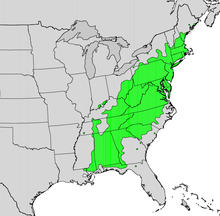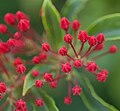Kalmia latifolia
| Kalmia latifolia | ||||||||||||
|---|---|---|---|---|---|---|---|---|---|---|---|---|

Mountain laurel flowers ( Kalmia latifolia ) |
||||||||||||
| Systematics | ||||||||||||
|
||||||||||||
| Scientific name | ||||||||||||
| Kalmia latifolia | ||||||||||||
| L. |
Kalmia latifolia, also known as broad-leaved laurel rose or mountain laurel, is a species of laurel rose ( Kalmia ) within the heather family(Ericaceae).
description
Vegetative characteristics
The mountain laurel grows as an evergreen shrub , rarely also as a small tree , and reaches heights of 1 to 12, mostly 2 to 8 meters. The branches with a round cross-section are glandular and sticky due to pedunculated glands.
The alternate, seemingly lively heaped leaves on very slow-growing shrubs are divided into petioles and leaf blades. The petiole is 1 to 3 inches long. The simple leaf blade is 4 to 12 centimeters long and 1.5 to 5 centimeters wide, elliptical to elliptical-lanceolate with a pointed upper end. They too are sticky due to the stalk glands.
Generative characteristics
The flowering period extends from April to June. The terminal, racemose inflorescences each contain 20 to 40 flowers (rarely less). The flower stalk is 2 to 4 inches long.
The hermaphroditic flowers are radial symmetry and five-fold with a double flower envelope . The overgrown sepals are green to reddish in color, they are elongated and pointed at the end. The five petals are fused into a flower tube with short free corolla lobes. They are usually pink in color, but can vary in color from white to red. Inside, at their base, there are red dots or spots around the bases of the stamens . In culture there are different cultivars with darker flower colors up to red and chestnut brown.
The capsule fruits are five-chambered. The winged seeds are only 0.5 to 1 millimeter long.
Flower ecology
Kalmia latifolia is notable for the method of dispersing its pollen . As the flowers grow, the stamens on their stamens flex and develop tension. As soon as an insect lands on the flower, the tension is discharged and the pollen is thrown at the insect with force. Experiments have shown that the flowers can shoot their pollen up to six inches. Physicist Lyman J. Briggs studied the phenomenon extensively in the 1950s after retiring from the National Bureau of Standards .
Occurrence
Kalmia latifolia is widespread in North America and is usually called mountain laurel there. It is mainly found in the eastern United States . It occurs between Maine and Florida and to the west in Indiana and Louisiana . Kalmia latifolia is the state flower of Connecticut and Pennsylvania . Mountain-laurel is also namesake for the city of Laurel (Mississippi) (founded 1882). Kalmia latifolia thrives at altitudes between 0 and 1900 meters.
The natural habitats of Kalmia latifolia are on stony mountain slopes and as undergrowth in forests. It thrives best on acidic soils with pH values of 4.5–5.5. It often forms large thickets. In the Appalachians , it occasionally reaches tree height and forms an important part of the oak-heath forests . In low, wet areas it grows very densely, in drier high altitudes it develops increasingly loose habit.
Common names
English-language common names are, for example, mountain laurel , calico-bush , ivybush , sheep laurel , lambkill , clamoun , spurwood ("spur wood") and spoonwood ("spoon wood"). The last two names go back to the fact that the Indians once made their spurs and spoons from them.
Botanical history
This species was first described in America in 1624, but later named after Pehr Kalm , who sent samples to Carl von Linné .
use
Use as an ornamental plant
The broad-leaved bay rose was imported to Europe as an ornamental plant in the 18th century . It is planted for its beautiful flowers. There are a number of cultivars with different flower colors. Many of them come from the Connecticut Experiment Station in Hamden or from Richard Jaynes' nursery . Jaynes has named many cultivars and is considered an authority on Kalmia latifolia.
The cultivar 'Pink Charm' has won the Award of Garden Merit from the Royal Horticultural Society .
Wood

The wood of the mountain laurel is heavy and strong, but brittle, with a narrow, straight grain . It was never used for commercial purposes because it doesn't get big enough. But it is common for wreaths, furniture, vessels, and household items. It was used in wooden clocks in the early 19th century. Burls were used as pipe bowls. The branches are also used as handrails and railings.
Traditions of the "Native Americans"
The Cherokee use plant extracts as an analgesic by applying an infusion of the plant to the painful area or rubbing into scratches on the painful area. They also rub the bristly leaf edges over rheumatic areas, use the leaves as a disinfectant for wounds and extracts as a remedy for vermin and cramps. They also use the wood for carving.
The Hudson Bay Cree use a potion made from the leaves as a remedy for diarrhea , but consider the plant generally toxic.
The Mahuna consider the plant poisonous, but use the leaves as fodder for deer and as perfume.
Toxicity
All parts of the plant are poisonous. Mountain laurel is poisonous due to grayanotoxin and arbutin , for horses, goats, cattle and deer as well as monkeys and humans. All plant parts and food (honey) made from plant parts can lead to digestive tract complaints . Fortunately, the corresponding honey is quite bitter. It is non-toxic to bees and can be used as winter food. Symptoms of poisoning become noticeable about 6 hours after ingesting the poison. Symptoms include irregular breathing, loss of appetite, difficulty swallowing, increased salivation, lacrimation, heart problems, coordination problems , depression , Passing , diarrhea, weakness and cramps through to paralysis and rarely coma and death. Autopsies of animals that perished from spoonwood poisoning show internal bleeding.
Mountain laurel in literature
Calico Bush is a novel by Rachel Field . The story revolves around a French orphan who is kept as a domestic servant on a New England farm . The title also refers to a ballad mentioned in the book.
gallery
Individual evidence
- ↑ a b Kalmia latifolia in the Germplasm Resources Information Network (GRIN), USDA , ARS , National Genetic Resources Program. National Germplasm Resources Laboratory, Beltsville, Maryland. Retrieved November 12, 2015.
- ↑ a b c d e Gordon C. Tucker: Ericaceae. In: Flora of North America Association (editors): Flora of North America. Volume 8 Magnoliophyta: Paeoniaceae to Ericaceae Kalmia latifolia. Pp. 480–482, the same text online as the printed work.
- ↑ McNabb, W. Henry: Kalmia latifolia L. . United States Department of Agriculture.
- Jump up ↑ John R. Nimmo, Paula M. Hermann, MB Kirkham, Edward R. Landa: Pollen Dispersal by Catapult: Experiments of Lyman J. Briggs on the Flower of Mountain Laurel . In: Physics in Perspective . 16, No. 3, 2014, p. 383. Retrieved April 27, 2015.
- Jump up ↑ John R. Nimmo, Paula M. Hermann, MB Kirkham, Edward R. Landa: Pollen Dispersal by Catapult: Experiments of Lyman J. Briggs on the Flower of Mountain Laurel . In: Physics in Perspective . 16, No. 3, 2014. Retrieved April 27, 2015.
- ↑ a b Harriet L. Keeler: Our Native Trees and How to Identify Them . Charles Scribner's Sons, New York 1900, pp. 186-189.
- ^ The Natural Communities of Virginia Classification of Ecological Community Groups. ( Memento of the original from January 5, 2011 in the Internet Archive ) Info: The archive link was inserted automatically and has not yet been checked. Please check the original and archive link according to the instructions and then remove this notice. (Version 2.3), Virginia Department of Conservation and Recreation, 2010.
- ↑ MP Schafale, AS Weakley; 1990: Classification of the natural communities of North Carolina: third approximation. North Carolina Natural Heritage Program, North Carolina Division of Parks and Recreation.
- ↑ Sharon Shreet: Mountain Laurel . Flower and Garden Magazine. April – May 1996. Archived from the original on May 26, 2012. Info: The archive link was inserted automatically and has not yet been checked. Please check the original and archive link according to the instructions and then remove this notice. Retrieved November 23, 2010.
- ^ Richard A. Jaynes: Kalmia: Mountain Laurel and Related Species . Timber Press, Portland, OR 1997, ISBN 0-88192-367-2 .
- ↑ RHS Plant Selector - Kalmia latifolia 'Pink Charm' . Retrieved July 15, 2013.
- ↑ a b Species: Kalmia latifolia . In: Fire Effects Information Service . United States Forest Service . Retrieved October 3, 2011.
- ↑ a b Mountain Laurel . Wood Magazine.com. Retrieved October 3, 2011.
- ^ Gene Galbraith: The legacy of the Ogee Clock . September 12, 2006. Retrieved October 3, 2011.
- ↑ Linda Averill Taylor: Plants Used As Curatives by Certain Southeastern Tribes. Cambridge, MA. 1940. Botanical Museum of Harvard University (p. 48).
- ↑ Paul B. Hamel, Mary U. Chiltoskey: Cherokee Plants and Their Uses - A 400 Year History. Sylva, NC 1975, Herald Publishing Co. (p. 42).
- ^ EM Holmes: Medicinal Plants Used by Cree Indians, Hudson's Bay Territory. In: The Pharmaceutical Journal and Transactions. 1884. Volume 15, pp. 302-304 (p. 303).
- ^ John Bruno Romero: The Botanical Lore of the California Indians. New York 1954. Vantage Press, Inc. (p. 52).
- ↑ a b grayanotoxin . In: Bad Bug Book . US Food and Drug Administration . May 4, 2009. Retrieved October 7, 2011.
- ↑ a b c Alice B. Russell, James W. Hardin, Larry Grand, Angela Fraser: Poisonous Plants: Kalmia latifolia . In: Poisonous Plants of North Carolina . North Carolina State University . Archived from the original on January 13, 2013. Info: The archive link was inserted automatically and has not yet been checked. Please check the original and archive link according to the instructions and then remove this notice. Retrieved October 3, 2011.
- ^ Mountain Laurel . American Society for the Prevention of Cruelty to Animals (ASPCA). Retrieved October 3, 2011.
- ↑ Jenner L. Horton: Deer-resistant Ornamental Plants . Oregon State University Extension . July 1994. Archived from the original on January 13, 2013. Info: The archive link was automatically inserted and has not yet been checked. Please check the original and archive link according to the instructions and then remove this notice. Retrieved October 3, 2011.
- ↑ a b c d Kalmia latifolia . University of Pennsylvania School of Veterinary Medicine. Retrieved October 3, 2011.






